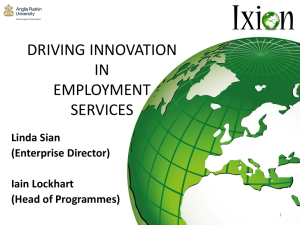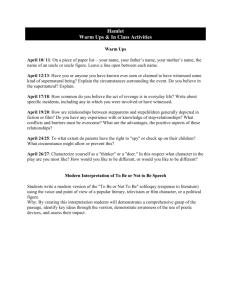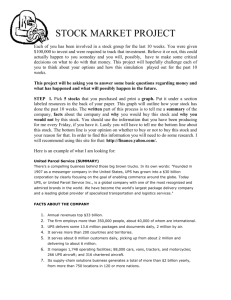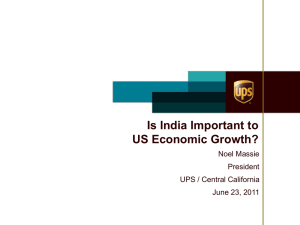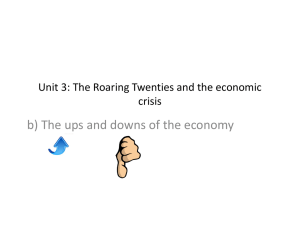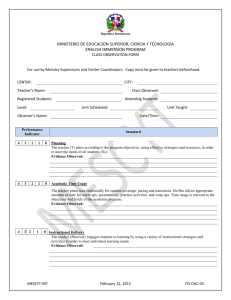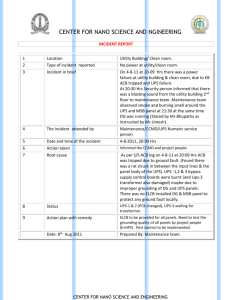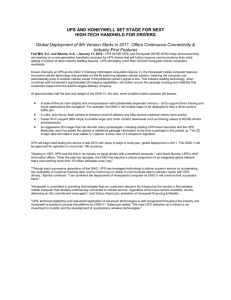Final Exam - Department of Computer Information Systems
advertisement
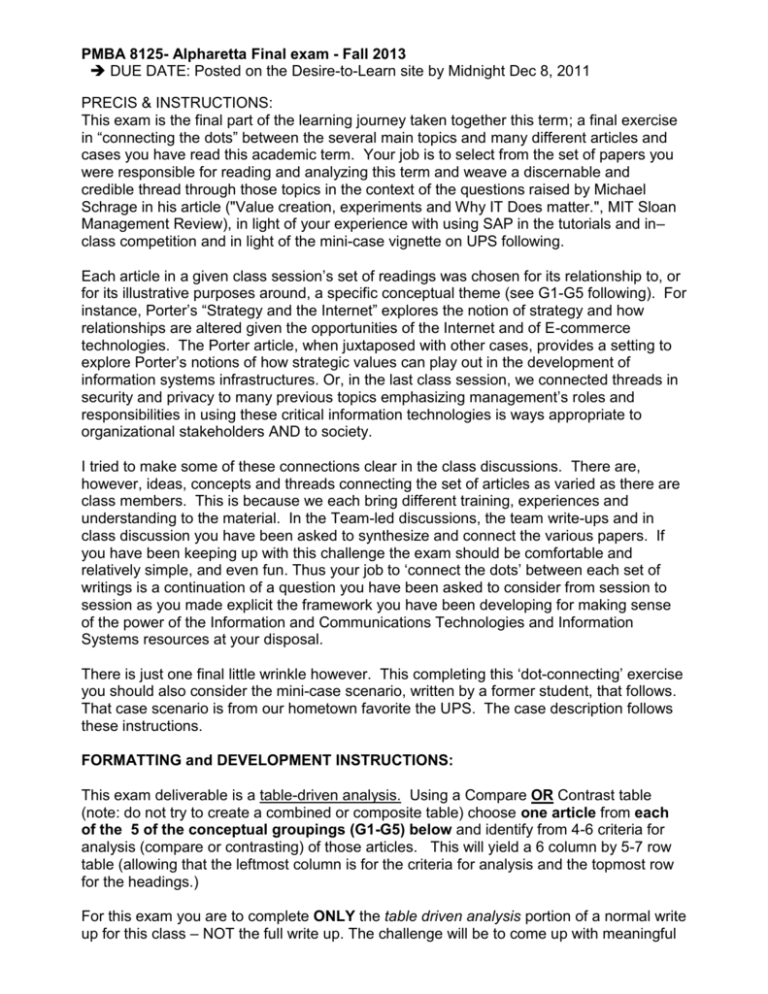
PMBA 8125- Alpharetta Final exam - Fall 2013 DUE DATE: Posted on the Desire-to-Learn site by Midnight Dec 8, 2011 PRECIS & INSTRUCTIONS: This exam is the final part of the learning journey taken together this term; a final exercise in “connecting the dots” between the several main topics and many different articles and cases you have read this academic term. Your job is to select from the set of papers you were responsible for reading and analyzing this term and weave a discernable and credible thread through those topics in the context of the questions raised by Michael Schrage in his article ("Value creation, experiments and Why IT Does matter.", MIT Sloan Management Review), in light of your experience with using SAP in the tutorials and in– class competition and in light of the mini-case vignette on UPS following. Each article in a given class session’s set of readings was chosen for its relationship to, or for its illustrative purposes around, a specific conceptual theme (see G1-G5 following). For instance, Porter’s “Strategy and the Internet” explores the notion of strategy and how relationships are altered given the opportunities of the Internet and of E-commerce technologies. The Porter article, when juxtaposed with other cases, provides a setting to explore Porter’s notions of how strategic values can play out in the development of information systems infrastructures. Or, in the last class session, we connected threads in security and privacy to many previous topics emphasizing management’s roles and responsibilities in using these critical information technologies is ways appropriate to organizational stakeholders AND to society. I tried to make some of these connections clear in the class discussions. There are, however, ideas, concepts and threads connecting the set of articles as varied as there are class members. This is because we each bring different training, experiences and understanding to the material. In the Team-led discussions, the team write-ups and in class discussion you have been asked to synthesize and connect the various papers. If you have been keeping up with this challenge the exam should be comfortable and relatively simple, and even fun. Thus your job to ‘connect the dots’ between each set of writings is a continuation of a question you have been asked to consider from session to session as you made explicit the framework you have been developing for making sense of the power of the Information and Communications Technologies and Information Systems resources at your disposal. There is just one final little wrinkle however. This completing this ‘dot-connecting’ exercise you should also consider the mini-case scenario, written by a former student, that follows. That case scenario is from our hometown favorite the UPS. The case description follows these instructions. FORMATTING and DEVELOPMENT INSTRUCTIONS: This exam deliverable is a table-driven analysis. Using a Compare OR Contrast table (note: do not try to create a combined or composite table) choose one article from each of the 5 of the conceptual groupings (G1-G5) below and identify from 4-6 criteria for analysis (compare or contrasting) of those articles. This will yield a 6 column by 5-7 row table (allowing that the leftmost column is for the criteria for analysis and the topmost row for the headings.) For this exam you are to complete ONLY the table driven analysis portion of a normal write up for this class – NOT the full write up. The challenge will be to come up with meaningful criteria for analysis (the left most cell of each row) Then complete the table cells with a sufficient data to convey the gist of your analysis and likely argument in an essay were you to have been required to write up your analysis. This exam requires a minimum of 5 articles, at least one article per conceptual grouping G1-G5 below. You are free to addk others articles if you feel so moved. NOTE AGAIN: Your deliverable is the table and NOT a full essay. Caveat on re-use of your old material. The learning and the final are cumulative. You are therefore allowed to be informed by and to ‘borrow from’ your previous team-led analysis write-ups. But the direct ‘borrowing’ is within certain limits. Stretch and look across all the cases and articles. For example you may NOT simply borrow the answers from others, say as shown in the recorded versions of the class discussions and plop it in as the deliverable in this exam. You are, however, free to be inspired by and to refer to these resources, but you need to make the insights your own. How marked/graded? The table will be marked on 1) the quality of your analysis criteria as well as 2) the keenness an clarity of your insight and the illustrations in the table cells. Remember the suggestions I have provided on the web page and in class for good evaluative criterion. This is an open book, open notes/previous work and open access to the Desire-to-learn and web distributed materials. It is NOT however open to your neighbor or other human source. Use your computer or make a legible (printed preferred) table on the provided worksheet. Turn the exam in on the sharepoint server in the usual way by Dec 8th (Sunday) midnight. You may submit the exam anytime before the deadline. The server will not accept submissions after this date and time. FORMAT: MS Word table in .doc or .docx file format. Do NOT submit pdf or .xls files. Construct the page layout in Panoramic (wide) format even though it is likely that the table will extend beyond one page. DUE DATE: This is a take-home exam that I am releasing the exam on Nov 20th. It is due by midnight Sunday Dec 8th. Deliver it to the course Desire-to-learn site, ‘Final Exam’ , location any time before the deadline. TIME ALLOWED: This is a timed exercise; on the honor system. Allow no more than 3.5 hours to the exercise of framing and preparing the table. ARTICLE GROUPINGS: For reference and as a reminder this is the article set we have read/covered to date the following five sets of articles/cases: G1 Setting the stage--Strategy Value Creation in a Digital Era 1. Nicolas Negroponte's "Being Digital" excerpts 2. "Apple's Supply Chain Secret" -BusinessWeek Nov 13, 2011 3. HBS Case: "Apple Inc in 2010", by David Yoffie and R. Kim, HBS case #9-710-467 4. Michael Porter, “Strategy and the Internet”, Harvard Business review March 2001, pp. 63-78. G2 Business Process Orientation 1. Jay Cousins and Tony Stewart: What is Business Process Design and Why Should I Care?, RivCom, Inc. Whitepaper, April 2002 (8 Pages) 2. Laury Verner (2004): The Challenge of Process Discovery, BP Trends, May 2004 (11 Pages) 3. Stephen H. Haeckel: Leading on demand business – Executives as architects, IBM Systems Journal, 42(3), 2003 G3 Business process IT & Innovation 1. Clayton M. Christensen and Michael Overdorf: Meeting the Challenge of Disruptive Change, Harvard Business Review, March-April 2000. (10 Pages) 2. Stephen M. Shapiro: The 7R’s of Process Innovation, The 24/7 Innovation Thought Leadership Series, 2002. 3. Case: Managing Innovation at Nypro, Inc. (A), Harvard Business School, 9-696-061, 1998. G4 Software Deployment, Configuration and Sourcing 1. "Software in Flux, Partly Cloudy and Sometimes Free" http://www.flatworldknowledge.com/pub/gallaugher#book-41198 2. Truex, R. Baskerville & H. Klein, "Growing Systems in Emergent Organizations", Communications of the ACM, August 1999, vol. 42, No 8. 3. P. Samuleson, "IBM's Pragmatic Embrace of Open Source", Communications of the ACM, Oct. 2006 v. 49 4. Article: "A Relationship Perspective on IT Outsourcing", Kishore et al Communications of the ACM December, v. 46, #122003 5. Article: "Why Nearsourcing Means that Distance Matters", E. Carmel and P. Abbott, Communications of the ACM, v. 50 #10 Oct. 2007 G5 “The Dark Side” Management’ Role(?) in assuring Security & Privacy 1. Cyber Gold article, “Gold Rush: Online payment systems like e-gold Ltd. Are becoming the currency of choice for cybercrooks”, BusinessWeek, Jan 9 2006. 2. Bloomberg BusinessWeek: "Facebook Sells Your Friends" 3. HBR article: "What Was Privacy?", by Lew McCreary, Harvard Business review, October 2008 (R0819) 4. "We Googled You", by Diane Coutu, HBR case and commentatry,June 2007, #R0706A 5. "When hackers Turn to Blackmail", by Caroline Eisenmann, HBR Case study and commentary, October 2009, #R0910B Case scenario At UPS, IT Does Matter: A UPS Story From Pamela Perkins, MBA student alumnus I have been an employee of UPS for the past 16 years. In that time I’ve seen tremendous change in how we conduct our business internally and provide services to our external customer. Our core business is still the same; we move customers’ packages or freight from point A to point B. During my tenure, UPS has developed a strong position in the world of supply chain management. Until the early 1990’s, UPS drivers performed a process called “sheeting up” a package before a customer signed or the delivery. Every evening those hundreds and thousands of sheets were turned in to the package centers to be sent to billing and delivery information. Yes, these pages were maintained for years as hard copies. When scanning technology was introduced they were later scanned into a data storage system. It sounds archaic but this was the method of delivery until the Delivery Information Acquisition Device (DIAD) revolutionized the package delivery business in 1991. UPS is now in its 4th generation of the DIAD which adds GPS capabilities to our drivers. Package tracking information can be captured immediately and sent over the web to awaiting customers wanting information on about their packages. Good example. IT matters to UPS. Without it we would be just another big “mom and pop” delivery service. IT helps to enable innovative business practices.!!! Another one employed at UPS is our Flex Global View system. We use this as a solution in our supply chain management business. This tool enables our customers to track their inventory and freight anywhere in the world. We have moved into a world of global commerce. The IT solution represented by FGV is in response to the changes in how businesses operate. The software does use the best practices of the industry and combines them with proprietary strategic company goals. IT helps UPS respond to needs in the environment. In a quote from a UPS press release in January, “Introduced in January, the industry-first solutions - UPS Paperlesssm Invoice and international UPS Returns® - now are available within the UPS Shipping Tool, an application program interface (API) that enables customers to integrate them into their own web sites and enterprise applications. They're already helping thousands of UPS customers manage shipments to 98 countries and territories around the world via UPS shipping systems like UPS WorldShip®, UPS CampusShip™ and UPS Internet Shipping.” The above new technology is an example of a web based service operations architecture (SOA) being deployed as a solution to address business and environmental concerns. The use of the internet enables this SOA deployment. This innovation cannot be merely dismissed as the “accelerated commoditization of IT.”

